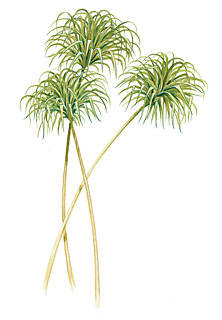Papyrus, << puh PY ruhs, >> is a water plant whose stalks contain fibers. The people of ancient Egypt used the plant to make a writing material, also called papyrus. It served also as a material for mats, sandals, and sailcloth for light skiffs. The brownish flowers were made into garlands for the shrines of the Egyptian gods. Many people think the mother of Moses hid her son in an ark made of papyrus.

The papyrus plant still grows in the Nile Valley of Egypt. It is also found in Ethiopia, Syria, southern Italy, and Sicily. The plant’s reedlike stems grow 3 to 10 feet (0.9 to 3 meters) high. As many as 100 flower stalks spring from the top of each stem. These stalks may be more than 12 inches (30 centimeters) long. Coarse bracts (leaflike structures) surround the cluster of stalks. The flowers grow in clusters at the ends of the stalks.
The Egyptians made the writing material called papyrus by laying strips of the plant’s stem in layers. Then they applied pressure to the layers. The crushed strips matted into a loose-textured, porous, white paper. Time has turned surviving papyrus manuscripts brown and brittle. The paper was sold as long, rectangular sheets of different sizes. The sheets were at first rolled and tied with a string. Later they were bound together into books. Until the 100’s B.C., Egypt guarded its monopoly on the preparation of the paper. Then papyrus was gradually replaced by the more durable parchment.
